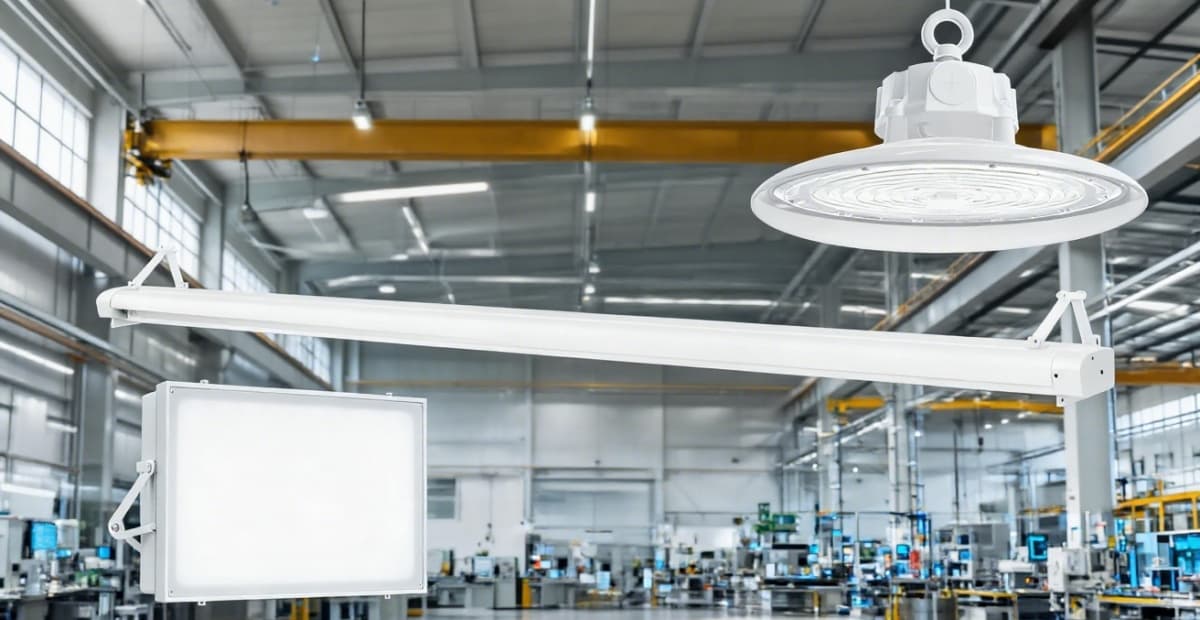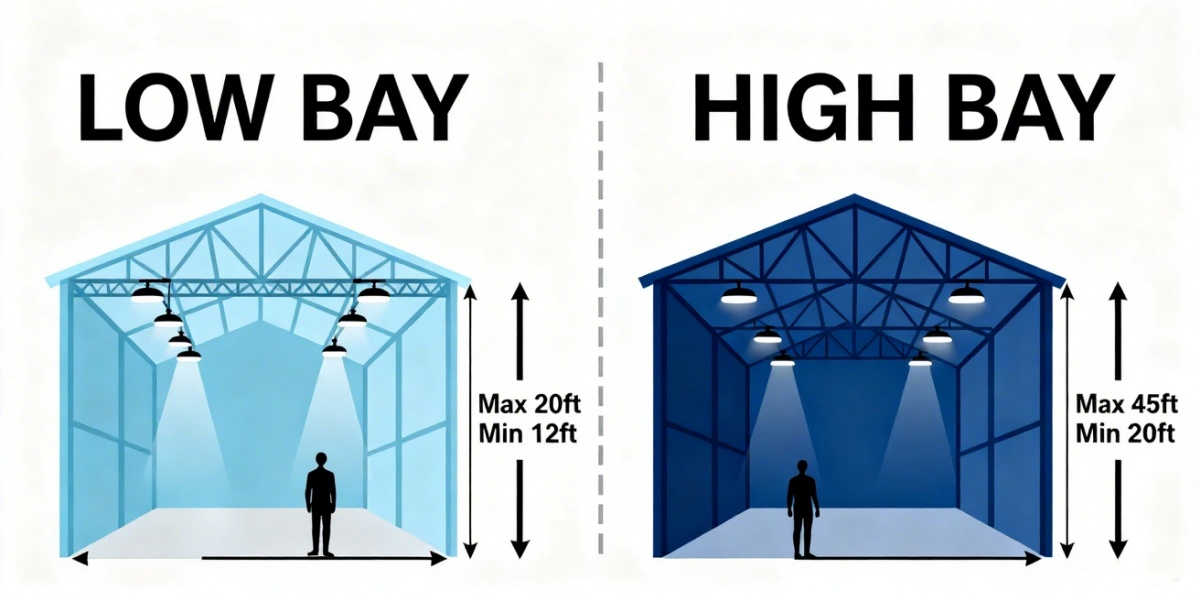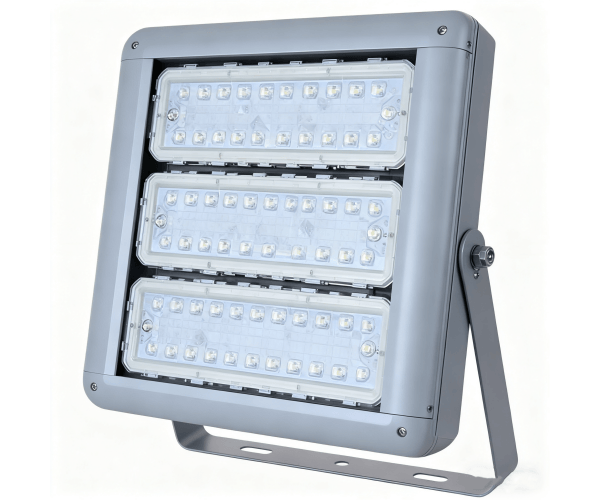Industrial LED High Bay Lighting: Complete Guide

Big spaces need big lighting power — and that’s where Industrial LED High Bay Lighting steps in.
If you’ve ever wondered how to light up a massive industrial space without wasting energy or money, this guide will walk you through everything you need to know.
Directory:
What Is Industrial LED High Bay Lighting?
High Bay vs. Low Bay Lighting — Key Differences
Types of Industrial LED High Bay Lights
Where Are High Bay LED Lights Used?
Top 3 Benefits of Industrial LED High Bay Lights
What’s the ROI of Industrial LED High Bay Lighting?
How to Plan Your High Bays Layout?
What Is Industrial LED High Bay Lighting?
Industrial LED high bay lighting sounds fancy, but the idea is pretty simple — it’s lighting made for tall spaces where normal lamps just don’t cut it. Think of places like factories, warehouses, or airplane hangars with ceilings higher than 20 feet.
When the roof’s that far away, you need powerful, focused light that actually reaches the floor. That’s exactly what high bay lights are built to do.
Traditional options like metal halide or fluorescent lights used to be the go-to, but let’s be honest — they burn hot, eat electricity, and love to burn out at the worst times.
Industrial LED lights flip that story around. They deliver the same (or better) brightness while using roughly half the energy, and they can keep glowing for 50,000 hours or more before you even think about maintenance.
In short, they’re the smarter, tougher, and more efficient way to light big industrial spaces. The right high bay system can turn a dull, shadowy warehouse into a bright, safe, and energy-saving workspace.

High Bay vs. Low Bay Lighting — Key Differences
Ever walked into two different factories and noticed one feels “sunny bright” while another looks evenly lit but softer? That difference often comes down to high bay vs. low bay lighting — two systems designed for very different ceiling heights and lighting needs.
High bay lighting is made for tall spaces — usually 20 feet or higher — where light has to travel farther and stay strong. It uses narrower beam angles to focus brightness on the working area below.
Low bay lighting, on the other hand, fits better in rooms below 20 feet, using wider beam angles to spread light evenly across shorter distances. It’s perfect for workshops, retail areas, and garages where you don’t need that long “light throw.”

Here’s a quick comparison chart to make it clear:
Feature | High Bay Lighting | Low Bay Lighting |
Mounting Height | Over 20 ft (6 m) | Under 20 ft (6 m) |
Beam Angle | Narrow (60°–120°) | Wide (120°+) |
Applications | Warehouses, factories, gymnasiums, hangars | Workshops, garages, retail stores, corridors |
Light Distribution | Focused, bright, less reflection | Softer, even illumination |
Maintenance | Harder to reach, but long lifespan | Easier to maintain, replaced more often |
In short — choose by height, not shape. If your lights need to reach down from a tall ceiling, go for high bays. For smaller rooms or lower ceilings, low bay industrial LED lighting is the smarter pick.
Types of Industrial LED High Bay Lights
Every industrial space has its own personality — some are long and narrow like a warehouse aisle, others wide and open like a factory floor.
That’s why LED high bay lights come in three main designs: linear high bay lights, UFO LED high bay lights, and modular high bay lights. Each type suits a different kind of workspace and lighting goal.
Here’s the quick overview:
Type | Ideal For | Key Features | Typical Look |
Linear High Bay Lights | Warehouses, aisles, production lines | Even light distribution, great for long narrow areas | Rectangular or strip shape |
UFO LED High Bay Lights | Open spaces — factories, gyms, workshops | Compact, powerful, easy to mount | Round, disc-like design |
Modular High Bay Lights | Large industrial zones, customized projects | Adjustable modules, scalable brightness, simple maintenance | Panel-style structure |
Type 1: Linear High Bay Lights
Think of linear high bay lights as the go-to choice for warehouses and production corridors. Their long, rectangular body throws light evenly along the entire aisle — ideal when you need consistent brightness from one end to the other. They fit neatly between shelving rows and reduce shadows, keeping your workspace safe and easy on the eyes.

Type 2: UFO LED High Bay Lights
Compact, round, and tough — UFO LED high bay lights are built for open industrial areas where height and coverage matter most. Despite their small footprint, they deliver impressive brightness and excellent beam control. Their design also makes installation refreshingly simple — hang, connect, and you’re good to go. Perfect for factories, workshops, and sports halls that need powerful, uniform light.

Type 3: Modular High Bay Lights
For projects that demand flexibility, modular high bay lights are the practical solution. Their modular structure means you can combine multiple LED panels for higher output or adjust the beam direction to fit the layout. They’re widely used in large industrial plants or custom-designed lighting systems where performance and scalability go hand in hand.

In short — linear lights keep aisles bright and even, UFO lights handle open spaces with ease, and modular lights give you total control.
Where Are High Bay LED Lights Used?
Where do high bay LED lights really shine? Anywhere the ceiling is high, the work is serious, and the lighting can’t afford to be lazy.
These fixtures are the go-to choice for warehouses, factories, workshops, gyms, and even airplane hangars — basically, any space that needs bright, consistent illumination from above.
In warehouses and distribution centers, lighting needs to reach deep between shelves without creating shadows. Linear high bays are perfect here — they throw even light across long aisles so workers can see every barcode clearly.
In factories and production facilities, brightness and safety rule the game. Machines, tools, and people all move fast, so strong, uniform light reduces accidents and eye strain. UFO or modular high bays handle these heavy-duty tasks effortlessly, keeping everything visible and efficient.
Workshop lighting deserves a spotlight of its own. These spaces demand clarity and focus — whether it’s metal fabrication, car repair, or fine assembly work. High bay LEDs deliver the crisp, shadow-free visibility workers rely on, with excellent color accuracy to distinguish materials and finishes.
And in gyms or sports halls, the goal shifts to comfort. You want plenty of light without glare, ensuring players see the ball — not stars. High bay LEDs balance intensity and diffusion, creating a bright but friendly environment.
No matter the space, the right fixture design — linear for aisles, UFO for open areas, modular for customization — ensures your lighting is doing more than just shining; it’s working as hard as you do.
Top 3 Benefits of Industrial LED High Bay Lights
Why are so many factories replacing metal halide or fluorescent fixtures with LED high bays?
It’s not just about keeping up with technology trends — it’s about getting better light for less money. Industrial LED high bay lighting combines efficiency, reliability, and performance in one smart package that pays for itself over time.
Benefit 1: Energy Efficiency & Power Saving
Let’s start with the obvious win — energy bills. LED high bay lights use 60–70% less power than metal halide and around 40% less than fluorescent systems. They convert more electricity into light instead of heat, which means you get brighter illumination without turning your factory into an oven. In short: less power, more light, smaller bills.
Benefit 2: Longevity & Maintenance
Tired of changing bulbs on a 30-foot ceiling? LEDs have you covered. With lifespans of 50,000–100,000 hours, they last five to ten times longer than metal halide lamps. That means fewer replacements, less downtime, and happier maintenance crews. Industrial spaces like warehouses and factories love that kind of consistency.
Benefit 3: Light Quality & Performance
LED high bays also shine (literally) when it comes to light quality. They deliver a high CRI (80+), providing natural, accurate color visibility that reduces eye strain. No warm-up time, no flickering — just clean, steady light from the moment you flip the switch.
No flicker, no waiting, no drama — just clean, consistent light.
Quick Comparison: LED vs. Traditional Lighting
Feature | LED High Bay | Metal Halide | Fluorescent |
Energy Efficiency | ★★★★★ | ★★☆☆☆ | ★★★☆☆ |
Lifespan | 50,000–100,000 hrs | 10,000 hrs | 15,000–20,000 hrs |
Warm-Up Time | Instant | 5–10 min | Instant |
CRI | 80+ | 65–70 | 75 |
Maintenance | Low | High | Medium |
LED high bay lights aren’t just replacements — they’re upgrades that redefine how industrial spaces are illuminated.
What’s the ROI of Industrial LED High Bay Lighting?
Switching to industrial LED high bay lighting isn’t just a lighting upgrade — it’s a smart business move. Many facility managers start with one simple question: “Will it actually pay off?” The short answer? Yes — and usually faster than you’d expect.
Energy Savings That Add Up Fast
Energy costs are the biggest chunk of any lighting budget. LED high bays use 50–70% less electricity compared to metal halide fixtures and about 40% less than fluorescent systems. For a warehouse running 100 fixtures at 400W each, that’s roughly $10,000–$15,000 saved per year (depending on local rates and operating hours).
Less power drawn, less heat produced — your lighting bill (and your air conditioning bill) both go down.
Tip: Check your utility’s rebate programs — many offer cash incentives for upgrading to LED systems.
Longer Lifespan, Lower Maintenance
Here’s another hidden ROI factor: maintenance. LED high bay lights typically last 50,000–100,000 hours, meaning you can go 8–10 years before replacements. Compare that to metal halides, which need re-lamping every 1–2 years.
That’s fewer lifts, fewer ladders, and fewer interruptions to production. And in industrial settings, every maintenance hour you save is an hour of work you don’t lose.
Realistic Payback Period: 3–5 Years
In most industrial applications, LED upgrades deliver a return on investment within 3 to 5 years. After that, the energy and maintenance savings are pure profit.
For example, a facility that spends $20,000 annually on lighting can see its costs drop to around $7,000 after switching to LED — saving $13,000 each year. Multiply that over five years, and the numbers speak for themselves.
ROI Beyond the Spreadsheet
Sure, the financial side is great — but LEDs also improve lighting quality, worker safety, and comfort, which can indirectly boost productivity. Better light equals fewer mistakes and happier employees.
In short: industrial LED high bay lighting isn’t an expense; it’s an investment that pays for itself, one bright workspace at a time.
How to Plan Your High Bays Layout?
Getting industrial LED lighting right isn’t just about picking the best fixture — it’s about knowing how to plan the layout. These two questions—quantity and brightness—are what truly shape a good lighting plan.
Let’s walk through how to get both right without turning your factory floor into either a spotlight stage or a cave.
Step 1: Measure Your Space
Before diving into any calculations, start with the basics: measure your space. You’ll need:
Area: in square meters or square feet
Ceiling height: the higher it is, the stronger your lights need to be
Surface reflectivity: bright walls bounce light better than dark ones
Purpose: production lines, warehouses, or inspection zones each need different brightness levels
A warehouse and a gym might be the same size — but they definitely don’t need the same light levels.
Step 2: Estimate Lamp Quantity
Once you’ve got your measurements, here’s a quick way to estimate how many fixtures you’ll need.
A general formula goes like this:
Number of lights ≈ (Target Lux × Area) ÷ (Lumens per fixture × Utilization factor)
Let’s say you have a 1,000 m² warehouse, aiming for 300 lux, and you’re using 26,000-lumen high bays. You’ll need around 12–14 fixtures for balanced coverage.
Of course, professional lighting design software like Dialux or Relux can provide more precise results, but this quick math gives you a solid starting point for budgeting.
Step 3: Choose the Right Brightness (High Bay Lumens Chart)
Here’s a simple reference chart to help match your ceiling height with the ideal light output:
Mounting Height | Recommended Lumens per Fixture | Typical Application |
20–30 ft | 22,000–35,000 lm | Warehouse, workshop |
31–40 ft | 35,000–47,000 lm | Factory, gym, hangar |
40+ ft | 47,000+ lm | Heavy industry, aircraft bays |
The logic is simple: the higher the ceiling, the more powerful the fixture. Go too dim, and you’ll have dark corners and safety risks. Go too bright, and you’ll waste watts and money. Balance is key.
Step 4: Fine-Tune for Efficiency
Once you’ve nailed the basics, optimize with the right beam angle and layout pattern:
Wide beam (120°): better for low ceilings and open areas
Narrow beam (60°–90°): ideal for high ceilings or focused lighting zones
Think of it as lighting choreography — the right placement keeps every corner bright without stepping on your power bill.
Conclusion
Industrial LED high bay lighting isn’t just about brightness — it’s about efficiency, safety, and real ROI. By switching to LEDs, factories and warehouses cut energy bills, reduce maintenance, and create a safer, brighter workspace for years to come.
Ready to take the next step?
Explore Ceramiclite’s HB01 LED high bay lights designed for every industrial environment, or contact our experts for a free lighting audit to see how much you could save.
FAQs
Q1: Can LED high bay lights be used outdoors?
Yes — as long as they’re rated IP65 or higher. That rating means they’re dust-tight and weatherproof enough for outdoor or semi-outdoor spaces like loading docks or covered stadiums. Just don’t stick an indoor fixture out in the rain and expect it to thank you.
Q2: Are LED high bay lights dimmable for flexible lighting control?
Absolutely. Many Ceramiclite models support 0–10V dimming or smart controls, letting you adjust brightness based on task or daylight. It’s not just convenient — it also saves energy and extends the lamp’s lifespan. Think of it as giving your factory its own mood lighting (but for productivity, not romance).
Q3: What warranties do Ceramiclite high bay lights come with?
Most of our fixtures include a 8-year warranty, covering both performance and parts. Because industrial lighting isn’t a short-term investment — and we stand behind every lumen we sell.
Q4: How long do LED high bays last?
Typically 50,000 to 100,000 hours, depending on usage and environment. That’s roughly 10 years of reliable lighting — far longer than metal halide or fluorescent alternatives. In short: install once, relax for years.
Q5: Are LED lights just a trend that’ll fade away?
Not a chance. LEDs are the future of industrial lighting — energy-efficient, smart-ready, and built to last. Traditional bulbs are the ones fading out.
Q6: How should I handle old lights during replacement?
Metal halide and fluorescent bulbs often contain materials that need proper recycling or disposal. Ceramiclite’s support team can help you connect with certified recyclers, so your upgrade is clean, safe, and compliant.
_thumb.jpg)